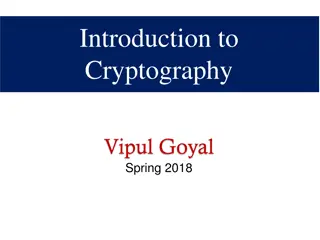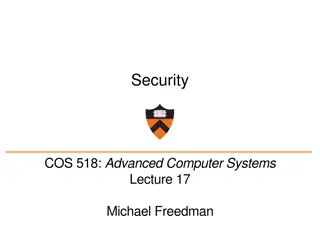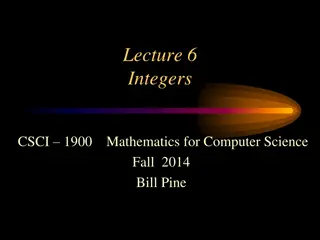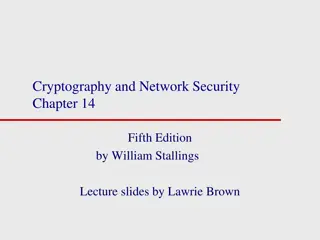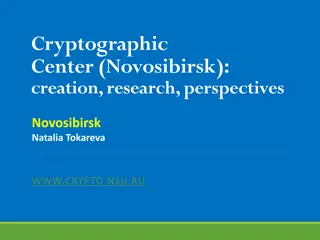Introduction to Cryptography and Its Applications in Computer Science
Cryptography is the study of methods for sending and receiving secret messages. In this lecture, we explore the design and application of cryptosystems, such as the RSA cryptosystem and Turing's Code. The goal is to securely encrypt and decrypt messages using number theory to protect communication from adversaries.
Download Presentation

Please find below an Image/Link to download the presentation.
The content on the website is provided AS IS for your information and personal use only. It may not be sold, licensed, or shared on other websites without obtaining consent from the author.If you encounter any issues during the download, it is possible that the publisher has removed the file from their server.
You are allowed to download the files provided on this website for personal or commercial use, subject to the condition that they are used lawfully. All files are the property of their respective owners.
The content on the website is provided AS IS for your information and personal use only. It may not be sold, licensed, or shared on other websites without obtaining consent from the author.
E N D
Presentation Transcript
Cryptography Dec 29
This Lecture In this last lecture for number theory, we will see probably the most important application of number theory in computer science the design of cryptosystem. Introduction to cryptograph Turing code Public key cryptography RSA cryptosystem
Cryptography Cryptography is the study of methods for sending and receiving secret messages. message Alice Bob adversary Goal: Even though an adversary can listen to your conversation, the adversary can not learn what the message was.
Cryptography Goal: Even though an adversary can listen to your conversation, the adversary can not learn what the message was. f(message) Alice Bob encrypt the message decrypt the message message -> f(message) f(message) -> message adversary But the adversary has no clue how to obtain message from f(message) A difficult goal!
Key Goal: Even though an adversary can listen to your conversation, the adversary can not learn what the message was. f(message, key) Alice Bob encrypt the message using the key decrypt the message using the key message -> f(message,key) f(message,key) -> message adversary But the adversary can not decrypt f(message,key) without the key Use number theory!
This Lecture Introduction to cryptograph Turing code Public key cryptography RSA cryptosystem
Turings Code (Version 1.0) The first step is to translate a message into a number v i c t o r y -> 22 09 03 20 15 18 25 Beforehand The sender and receiver agree on a secret key, which is a large number k. Encryption The sender encrypts the message m by computing: m* = m k Decryption The receiver decrypts m by computing: m*/k = m k/k = m
Turings Code (Version 1.0) mk Alice Bob m = message k = key encrypted message = mk mk = received message k = key decrypted message = mk/k=m adversary Why the adversary cannot figure out m? The adversary doesn t have the key k, and so can only factor mk to figure out m, but factoring is a difficult task to do.
Turings Code (Version 1.0) mk Alice Bob m = message k = key encrypted message = mk mk = received message k = key decrypted message = mk/k=m adversary So why don t we use this Turing s code today? Major flaw: if you use the same key to send two messages m and m , then from mk and m k, we can use gcd(mk,m k) to figure out k, and then decrypt every message.
Turings Code (Version 2.0) Beforehand The sender and receiver agree on a large prime p, which may be made public. (This will be the modulus for all our arithmetic.) They also agree on a secret key k in {1, 2, . . . , p 1}. Encryption The message m can be any integer in the set {0, 1, 2, . . . , p 1}. The sender encrypts the message m to produce m* by computing: m* = mk mod p Decryption Let k be the multiplicative inverse of k under modulo p. m* mk (mod p) m*k m (mod p) m*k = m
Turings Code (Version 2.0) Public information p m* = mk mod p Alice Bob m = message k = key encrypted message = mk mod p m* = received message k = key decrypted message = m*k =m adversary Why the adversary cannot figure out m? Many m and k can produce m* as output, just impossible to determine m without k.
Turings Code (Version 2.0) Public information p m* = mk mod p Alice Bob m = message k = key encrypted message = mk mod p m* = received message k = key decrypted message = m*k =m adversary So why don t we use this Turing s code today? If the adversary somehow knows m, then first compute m := multiplicative inverse of m m* mk (mod p) m*m k (mod p) So the adversary can figure out k. plain-text attack
This Lecture Introduction to cryptograph Turing code Public key cryptography RSA cryptosystem
Private Key Cryptosystem f(message, key) Alice Bob encrypt the message using the key decrypt the message using the key message -> f(message,key) f(message,key) -> message adversary But the adversary can not decrypt f(message,key) without the key Two parties have to agree on a secret key, which may be difficult in practice. If we buy books from Amazon, we don t need to exchange a secret code. Why is it secure?
Public Key Cryptosystem Public information: Key for Alice Public information: Key for Bob f(message, Bob s key) Alice Bob encrypt the message using Bob s key decrypt the message f(message,Bob s key) -> message message -> f(message,Bob s key) adversary But the adversary can not decrypt f(message, Bob s key)! Only Bob can decrypt the message sent to him! There is no need to have a secret key between Alice and Bob. How is it possible???
RSA Cryptosystem RSA are the initials of three Computer Scientists, Ron Rivest, Adi Shamir and Len Adleman, who discovered their algorithm when they were working together at MIT in 1977.
This Lecture Introduction to cryptograph Turing code Public key cryptography RSA cryptosystem Key generation, encryption, decryption Correctness Secure? Computational issues
Generating Public Key public key: e and n Alice Bob secret key: d How Bob creates his public keys? Secret key only known to Bob. Choose 2 large prime numbers p and q. Set n = pq and T = (p-1)(q-1) Choose e 1 so that gcd(e,T)=1 Calculate d so that de = 1 (mod T) Publish e and n as public keys Keep d as secret key > 150 digits
Encrypting Message message x public key: e and n Send y = xemod n Alice Bob secret key: d How Alice sends a message to Bob? Look at Bob s homepage for e and n. Send y = xemod n Alice does not need to know Bob s secret key to send the message.
Decrypting Message message x public key: e and n Send y = xemod n Alice Bob secret key: d How Bob recover Alice s message? Receive y = xemod n Compute z = ydmod n Bob uses z is the original message that Alice sent.
RSA Cryptosystem message x public key: e and n Send y = xemod n Alice Bob Encrypting message secret key: d Key generation Choose 2 large prime numbers p and q. Set n = pq and T = (p-1)(q-1) Choose e 1 so that gcd(e,T)=1 Calculate d so that de = 1 (mod T) Publish e and n as public keys Keep d as secret key Decrypting message Compute z = ydmod n
This Lecture Introduction to cryptograph Turing code Public key cryptography RSA cryptosystem Key generation, encryption, decryption Correctness Secure? Computational issues
RSA Cryptosystem message x public key: e and n Send y = xemod n Alice Bob secret key: d Compute z = ydmod n For the RSA cryptosytem to work, we need to show: 1) z = x 2) Without the secret key d, we can not compute the original message before the sun burns out. with additional assumptions
Correctness message x public key: e and n Send y = xemod n Alice Bob secret key: d 1) z = x Compute z = ydmod n Note that z = ydmod n = xedmod n. Therefore we need to prove x = xedmod n. p, q prime n = pq T = (p-1)(q-1) e s.t. gcd(e,T)=1 de = 1 (mod T) (a) x mod p = xedmod p (b) x mod q = xedmod q (c) x mod n = xedmod n Therefore, if Alice sends x < n, then Bob can recover correctly.
Correctness message x public key: e and n Send y = xemod n Alice Bob secret key: d (a) x mod p = xedmod p 1) z = x Compute z = ydmod n = 1 + k(p-1)(q-1) Note that de = 1 + kT p, q prime n = pq T = (p-1)(q-1) e s.t. gcd(e,T)=1 de = 1 (mod T) Hence, xedmod p = x1+k(p-1)(q-1)mod p = x xk(p-1)(q-1)mod p = x (xk(q-1))(p-1)mod p
Correctness message x public key: e and n Send y = xemod n Alice Bob secret key: d (a) x mod p = xedmod p 1) z = x Compute z = ydmod n Fermat s little theorem: If p | a, then ap-1 1 mod p p, q prime n = pq T = (p-1)(q-1) e s.t. gcd(e,T)=1 de = 1 (mod T) Hence, xedmod p = x1+k(p-1)(q-1)mod p = x xk(p-1)(q-1)mod p = x (xk(q-1))(p-1)mod p a = x mod p
Correctness message x public key: e and n Send y = xemod n Alice Bob secret key: d (a) x mod p = xedmod p 1) z = x Compute z = ydmod n This means p | xk(q-1), implying p | x, since p is prime p, q prime n = pq T = (p-1)(q-1) e s.t. gcd(e,T)=1 de = 1 (mod T) Hence, xedmod p = x1+k(p-1)(q-1)mod p = x xk(p-1)(q-1)mod p = x (xk(q-1))(p-1)mod p What if p | a? a Since p | x, we have xedmod p = x mod p = 0.
Correctness message x public key: e and n Send y = xemod n Alice Bob secret key: d 1) z = x Compute z = ydmod n Note that z = ydmod n = xedmod n. Therefore we need to prove x = xedmod n. p, q prime n = pq T = (p-1)(q-1) e s.t. gcd(e,T)=1 de = 1 (mod T) (a) x mod p = xedmod p (b) x mod q = xedmod q (c) x mod n = xedmod n The same proof. (c) can be proved directly, also follows from Chinese Remainder theorem.
This Lecture Introduction to cryptograph Turing code Public key cryptography RSA cryptosystem Key generation, encryption, decryption Correctness Secure? Computational issues
Why is this Secure? message x public key: e and n Send y = xemod n Alice Bob adversary secret key: d Compute z = ydmod n 2) Without the secret key d, we can not compute the original message before the sun burns out. p, q prime n = pq T = (p-1)(q-1) e s.t. gcd(e,T)=1 de = 1 (mod T) Method 1: From y=xemod n, don t know how to compute x. Thus not possible to work backward. It is an example of an one-way function.
Why is this Secure? message x public key: e and n Send y = xemod n Alice Bob adversary secret key: d Compute z = ydmod n 2) Without the secret key d, we can not compute the original message before the sun burns out. p, q prime n = pq T = (p-1)(q-1) e s.t. gcd(e,T)=1 de = 1 (mod T) Method 2: Factor n = pq. Compute secrete key d. Then decrypt everything! No one knows an efficient way to do factoring. The security is based on assumptions that some computational problems are hard.
This Lecture Introduction to cryptograph Turing code Public key cryptography RSA cryptosystem Key generation, encryption, decryption Correctness Secure? Computational issues
RSA Example message x public key: e and n Send y = xemod n Alice Bob secret key: d Then Alice sends the encrypted message. Compute z = ydmod n x=33 y = 3323mod 55 p=5 q=11 n = 55 T = 40 e = 7 d = 23 p, q prime n = pq T = (p-1)(q-1) e s.t. gcd(e,T)=1 de = 1 (mod T) y = 84298649517881922539738734663399137 mod 55 How to compute it efficiently? First Bob generated his keys.
Exponentiation To compute exponentiation mod n 1444mod 713 = 144 * 144 * 144 * 144 mod 713 = 20736 * 144 * 144 mod 713 20736 * 20736 mod 713 = 59 * 144 * 144 mod 713 = 59 * 59 mod 713 = 8496 * 144 mod 713 = 3481 mod 713 = 629 mod 713 = 653 * 144 mod 713 = 94032 mod 713 This is much more efficient. = 629 mod 713 This still takes too long when the exponent is large.
Repeated Squaring 1442mod 713 = 59 Note that 50 = 32 + 16 + 2 1444mod 713 = 1442 1442mod 713 = 59 59 mod 713 = 629 14450mod 713 = 14432144161442mod 713 1448mod 713 = 1444 1444mod 713 = 629 629 mod 713 = 639 = 648 485 59 mod 713 = 242 14416mod 713 = 1448 1448mod 713 = 639 639 mod 713 = 485 14432mod 713 = 14416 14416mod 713 = 485 485 mod 713 = 648
Generating Public Key Choose 2 large prime numbers p and q. Set n = pq and T = (p-1)(q-1) Choose e 1 so that gcd(e,T)=1 Calculate d so that de = 1 (mod T) Publish e and n as public keys Keep d as secret key How to choose large prime numbers efficiently? Given a large number, how to check whether it is prime efficiently?
Primality Testing Given a large integer n, determine quickly whether n is prime First test: for i = 1, , n, check if i divides n. We are talking about n with 150 digits. This simply takes too long (2150steps, sun will burn out). We are looking for an exponential improvement (instead of n, we can only afford roughly log(n) steps), like we did in the extended GCD algorithm. Need some number theory!
Primality Testing Theorem: n is a prime if and only if (n-1)! -1(mod n) It doesn t seem to help, since we don t know how to compute (n-1)! mod n quickly (in roughly log(n) steps).
Primality Testing Theorem: If n is prime & a not a multiple of n 1 an-1 (mod n) Contrapositive. If 1 an-1 (mod n) and a is not a multiple of n, then n is not a prime number. Example. Show that 1763 is composite (not a prime number). Let a=2, n=1763. 21762(mod 1763) = 142 1 Therefore, it is composite by (the contrapositive of) Fermat s little theorem.
Primality Testing Contrapositive. If 1 an-1 (mod n) and a is not a multiple of n, then n is not a prime number. Example. Show that 1387 is composite (not a prime number). Let a=2, n=1387. can not tell whether n is prime or not. 21386(mod 1387) = 1 Try a=3 31386(mod 1387) = 1238 1 this shows n is composite.
Primality Testing Contrapositive. If 1 an-1 (mod n) and a is not a multiple of n, then n is not a prime number. Fermat test Given n, choose a < n Compute an-1 (mod n) If an-1 (mod n) 1 conclude that n is a composite number If an-1 (mod n) = 1 try another a Each test takes about log(n) steps. It depends on how many a that we need to try
Primality Testing Contrapositive. If 1 an-1 (mod n) and a is not a multiple of n, then n is not a prime number. Fermat test Given n, choose a < n Compute an-1 (mod n) If an-1 (mod n) 1 conclude that n is a composite number If an-1 (mod n) = 1 try another a Unfortunately, there exists n which is composite, but an-1 (mod n) = 1 for every a! These are called Carmichael numbers (e.g. 561, 1105, 1729, etc )
Primality Testing Contrapositive 1. If 1 an-1 (mod n) and a is not a multiple of n, then n is not a prime number. Lemma. If n is a prime number, x2 1 (mod n) if and only if x 1 (mod n) or x -1 (mod n) Contrapositive 2. If x2 then n is a composite number. 1 (mod n) but x 1 (mod n) and x -1 (mod n) Note that it is (2693)2 Example For n=1387 and a=2, Fermat s test fails because 21386 1 (mod 1387). However 2693 512 (mod 1387) 1 (mod 1387) By contrapositive 2, we can conclude that 1387 is a composite number.
Primality Testing Contrapositive 1. If 1 an-1 (mod n) and a is not a multiple of n, then n is not a prime number. Contrapositive 2. If x2 then n is a composite number. 1 (mod n) but x 1 (mod n) and x -1 (mod n) Strong primality test Let n-1 = 2kd Pick an a. Compute a2kd(mod n), a2k-1d(mod n), a2k-2d(mod n), , ad(mod n) 1 Composite by contrapositive 1.
Primality Testing Contrapositive 1. If 1 an-1 (mod n) and a is not a multiple of n, then n is not a prime number. Contrapositive 2. If x2 then n is a composite number. 1 (mod n) but x 1 (mod n) and x -1 (mod n) Strong primality test Let n-1 = 2kd Pick an a. Compute a2kd(mod n), a2k-1d(mod n), a2k-2d(mod n), , ad(mod n) =1 1 & -1 Composite by contrapositive 2.
Primality Testing Contrapositive 1. If 1 an-1 (mod n) and a is not a multiple of n, then n is not a prime number. Contrapositive 2. If x2 then n is a composite number. 1 (mod n) but x 1 (mod n) and x -1 (mod n) Strong primality test Let n-1 = 2kd Pick an a. Compute a2kd(mod n), a2k-1d(mod n), a2k-2d(mod n), , ad(mod n) =1 =1 Continue to go backward and check
Primality Testing Contrapositive 1. If 1 an-1 (mod n) and a is not a multiple of n, then n is not a prime number. Contrapositive 2. If x2 then n is a composite number. 1 (mod n) but x 1 (mod n) and x -1 (mod n) Strong primality test Let n-1 = 2kd Pick an a. Compute a2kd(mod n), a2k-1d(mod n), a2k-2d(mod n), , ad(mod n) =1 =1 =-1 End the test and say it is a probable prime.
Primality Testing Contrapositive 1. If 1 an-1 (mod n) and a is not a multiple of n, then n is not a prime number. Contrapositive 2. If x2 then n is a composite number. 1 (mod n) but x 1 (mod n) and x -1 (mod n) Strong primality test Let n-1 = 2kd Pick an a. Compute a2kd(mod n), a2k-1d(mod n), a2k-2d(mod n), , ad(mod n) =1 =1 =1 =1 =1 End the test and say it is a probable prime.
Primality Testing Strong primality test Given n, pick an a Let n = n-1 (so n is an even number) If an (mod n) 1, then stop and say n is composite . n := n /2; While n is an integer do If an (mod n) = -1, then stop and say n is a probable prime . If an (mod n) 1, then stop and say n is composite . n := n /2; Stop and say n is a probable prime .
Primality Testing For a particular a, the strong primality test takes about log(n) steps. But again, there exists n which is composite but pass the test Theorem: if n is composite, for more than half of a < n, the strong primality test will say n is composite! So, given a composite n, if we pick a random a, the strong primality test will be incorrect with probability <= 1/2. Thus, if we repeat the procedure for 10000 times, then the probability that the strong primality test is still incorrect is very small (e.g. much smaller than our computer will suddenly crash). This is the most efficient method used in practice!











